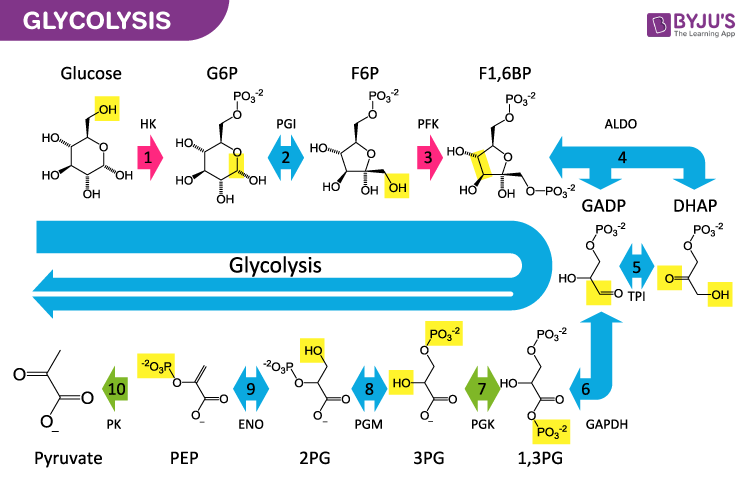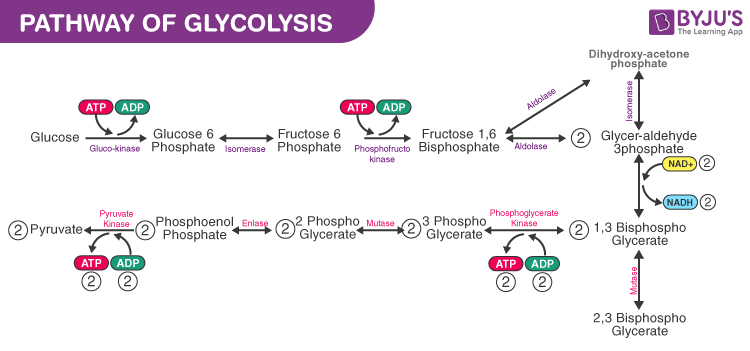
All living organisms undergo respiration. Although there are a wide variety of organisms, the biochemical reactions that constitute respiration are very similar in all organisms, starting from bacteria all the way to human beings. So what is glycolysis? It is the first step of respiration in all organisms.
Pathway of Glycolysis
Like all biochemical reactions, glycolysis follows a pathway, i.e., a series of chemical reactions each of which is catalyzed by a separate enzyme.

Glycolytic pathway is the first step in respiration, where glucose, the respiratory substrate, is oxidized to a simpler organic compound. This is an exergonic reaction, i.e., energy is released, which is used to produce ATP from ADP. ATP can then be used to drive life processes which require energy.
Where does glycolysis take place?
The reactions of the Glycolytic pathway takes place in the cytosol.
Key events in glycolysis
-
The initial requirement of ATP
ATP is required for the hydrolysis of ATP to ADP. In this reaction, energy is required in the same way:
For instance- A businessman has to invest money first to buy some goods so that he can then sell them at a higher price to make some profit.
Similarly, the cell first spends some ATP molecules, but later gets back more ATP molecules, so there is a net gain of ATP molecules. As mentioned in the above image, 1 molecule of ATP is used to make glucose-6-phosphate from glucose and fructose-1,6-bisphosphate from fructose-6-phosphate.
-
Oxidation
The overall process of glycolysis is an oxidation reaction. In this reaction, glyceraldehyde-3-phosphate is converted to 1,3-bisphosphoglycerate, which involves the oxidation of an aldehyde group to a carboxylic acid group. The electrons that are lost by glyceraldehyde-3-phosphate are taken up by NAD+, which gets reduced to NADH. The extra phosphate group of 1,3-bisphosphoglycerate comes from Pi (inorganic phosphate), which is nothing but a phosphate ion.
-
ATP formation
Finally, we come to the most exciting part. How does the cell produce high energy ATP molecules?
1,3-Bisphosphate-glycerate to 3-phosphoglycerate: Since the conversion of glyceraldehyde-3-phosphate to 1,3-bisphosphoglycerate is an oxidation reaction, it is exergonic. The energy released makes the phosphate linkage in carbon 1 of 1,3-bisphosphoglycerate a very high energy bond. This bond is next broken to release a lot of energy, which is then used to make an ATP molecule from an ADP molecule.
Phosphoenolpyruvate to pyruvate: This is the last step of glycolysis. The phosphate linkage in phosphoenolpyruvate has very high bond energy. This is broken to make ATP.
-
The fate of NADH
What happens to the NADH produced in the Glycolytic pathway? It has to be re-oxidized to NAD+ so that the Glycolytic pathway can continue to take place. It depends on whether the respiration is anaerobic or aerobic.
Anaerobic respiration: This occurs in the absence of oxygen.
- Production of lactic acid: The NADH, in order to get converted back to NAD+, gives its electrons to pyruvate, the end product of glycolysis. Pyruvate, in turn, gets reduced to lactate or lactic acid. This is what happens in curd formation by bacteria and in our muscles when we do some strenuous work.
- Production of ethanol: Pyruvate can also lose carbon to form acetaldehyde, which then accepts electrons from NADH to form ethanol. This is what happens in yeast and during anaerobic respiration in plants.
Aerobic respiration: In the presence of oxygen, NADH donates its electrons to oxygen through the electron transport chain in the mitochondrial inner membrane.
How many ATP molecules are produced by the Glycolytic pathway?
Substrate level phosphorylation: 2 ATP molecules per glucose molecule are invested initially in the glycolytic pathway. Later on, as mentioned above, two steps produce one ATP molecule each. However, from each glucose molecule, 2 molecules each of 1,3-bisphosphoglycerate and phosphoenolpyruvate are used. Hence, per glucose molecule, 4 ATP molecules are produced. ATP produced this way is called substrate-level phosphorylation.
Oxidative phosphorylation: When an NADH molecule gives its electrons to oxygen through the electron transport chain in mitochondria, 3 ATP molecules are produced. Since 2 NADH molecules are produced per glucose molecules, a total of 6 ATP molecules are produced by oxidative phosphorylation.
This was an introduction to glycolysis. For more information about glycolysis, visit BYJU’S.

Comments